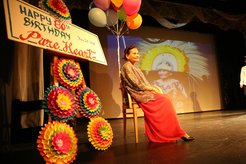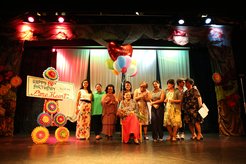1- As a visual artist, how did you become interested in capturing the stories of ageing migrants?
My choice to focus on ageing migrants is part of my own process as a migrant-artist. When I moved to Barcelona after studying in Madrid, I got involved with the Filipino community as a Spanish teacher to newly arrived Filipino migrants at the Centro Filipino, the civic arm of the Filipino church in Barcelona. This regular contact allowed me to socialize with overseas workers – both my students as well as other volunteers in charge of organizing those weekend classes – who would otherwise be in their respective places of work, many of them living with the families they were working for. The 4-hour Saturday classes became an opportunity for them to socialize with fellow Filipinos, which in turn gave me the chance to hear their stories first-hand, providing me with special insight into the lives of Filipino migrant workers.
My work with the Center also gave me the opportunity to share my skills as a filmmaker for the community's 25th anniversary in Spain. The leaders of the community at that time – Fr. Avelino Sapida and Sister Paulita Astillero – recognized the importance of documenting the activities of Centro Filipino and the Filipino church as they approached this milestone, and wanted to take advantage of my capacities to conduct interviews with those who had helped establish the Filipino community in Barcelona in the 1980s. I jumped at the opportunity, and the filming allowed me to hear even more stories of migration. I learned about migrants' personal backgrounds, their motivations for migrating to Spain, and their hopes and dreams for the future. This experience did not only deepen my knowledge of overseas Filipino workers' situations, it also triggered all sorts of questions about migration. My concerns, still mostly from my own perspective as a migrant, had a lot to do with choice – I wanted to know how they all came to choose such a life, why mothers chose to leave their children, or why they chose a country like Spain whose language they did not speak.
During that time, I also met Dr. Eva Marxen, an anthropologist who was conducting her doctoral research on the Filipino migrant community in Barcelona. She was initially interested in another short film I had made about Filipino migrants in Spain for the work she was doing, but our regular contact later evolved into occasions for exchanging stories, ideas and thoughts about our common focus; she eventually shared the results of her research with me. That was where I discovered the existence of the Philippine Labor Export Policy – a fact largely unknown to the average Filipino, including most migrant workers – and I believe that was what piqued my interest as a filmmaker. I couldn't wrap my head around the fact that a systematized export of Filipino workers actually existed. I felt it was necessary to explore this subject further and find a way to provoke discourse through film.
At around the same time, plans to set up a Center for Returning Migrants in the Philippines was already under way. Father Avelino had donated part of his family's property to the project as he wanted to continue “accompanying the migrants” back home, just as he had done in Europe for 30 years. Construction plans had been laid out, as well as talks on which retirees from Spain would be the Center's pioneer members and the projects they would be taking on back home. I knew this was a part of the migrant story worth following on film, although by that time, I had already attached the migrant story to the Labor Export Policy. Soon enough, it became apparent that the ageing migrants themselves were key to illustrating the significance of the Policy. I personally saw them as living consequences of a vast governmental scheme, and therefore, perhaps, the best place from which to question such a system. After decades of toil abroad, which seemed to be completely their choice (or non-choice), what was to become of them upon their return?

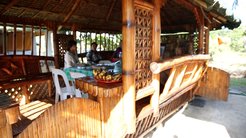
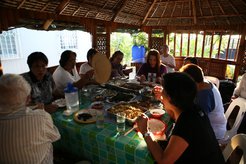
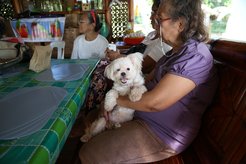
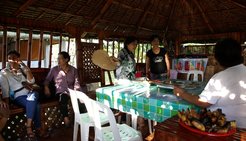
2- What can visual expressions of ageing migrants tell us about what matters in their lives?
I believe that one of the main roles of visual media, particularly of photography and film, is to give us the chance to “see” (i.e. to get more information about) what is usually not visible. Likewise, they give the invisible the chance to be seen. Therefore, I find these visual expressions ideal for telling the story of ageing migrants – a group of people often on the fringes, unseen, or seen from a very limited/limiting perspective – as they have the capacity to engage audiences through nuanced imagery that could provide different perspectives on private worlds. Simply put, film and photography can show us that they exist.
So far, what I've come to understand from my contact with migrant workers, both as a private individual and as a filmmaker is that, as one grows older, one is more compelled to tell one's life story. I suppose this would be true for most people, the very human need to be heard and understood – to attest one's existence. However, I find this need to be of great significance in the case of migrant workers. Ageing migrants particularly have a lot to say, and quite endearingly, they are often more than willing to say it in front of a camera. In my experience, no one has really been concerned about where and when the final product would be published, although I assume they may have some expectations, or hope that the rest of the world will hear their stories one day. Still, they open themselves up generously. Consequentially, this generosity has created in me a sense of obligation to publish their stories in any way I can.
I also remember what John Berger said in Ways of Seeing, that “the way we see things is affected by what we know or what we believe.” I find this idea very much related to my documentary film work with ageing migrants: what we might come to know if given the opportunity to really look at them, observe them, and to listen to them, could alter the way we perceive them, and perhaps the way we perceive migrants in general.
3- Could you share with us a few images/stories that have been particularly striking to you in your work so far?
Here is a short clip and some images of Purita, one of my protagonists in Barcelona. Purita is one of the first Filipino workers to arrive in Spain in the late 1960s. She is 80 years old. I chose to show you Purita as she exemplifies a quality a lot of ageing migrants have – they like to keep busy. Regardless of their circumstances, a lot of them continue to take part in various activities with their chosen community – at a church they attend, with a religious group, or as members of an association. After decades of work abroad, their main preoccupation is to be occupied. They also do not miss a chance to celebrate life. I personally find this inspiring.
Purita preparing afternoon snacks at the Benedictine Convent in Barcelona
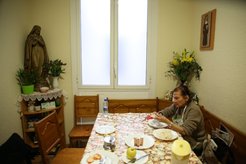
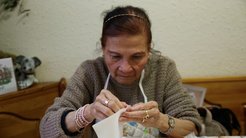
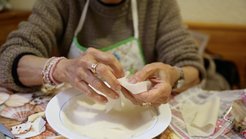
Friends of Purita organized a special dinner program to celebrate her 80th birthday. “Pure Heart” is the English translation of her two first names – Purita Corazon.
